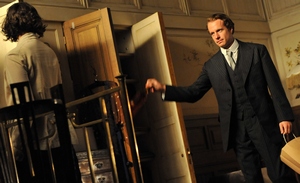SITE GUIDE
SEARCH
REVIEWS
REVIEW ARCHIVES
ADVERTISING AT CURTAINUP
FEATURES
NEWS
Etcetera and
Short Term Listings
LISTINGS
Broadway
Off-Broadway
NYC Restaurants
BOOKS and CDs
OTHER PLACES
Berkshires
London
California
New Jersey
DC
Philadelphia
Elsewhere
QUOTES
TKTS
PLAYWRIGHTS' ALBUMS
LETTERS TO EDITOR
FILM
LINKS
MISCELLANEOUS
Free Updates
Masthead
Writing for Us
A CurtainUp  London Review
London Review
 London Review
London ReviewPains of Youth
Cassie Robinson
|
Bourgeois existence or suicide. There are no other choices.— Desiree
|

Laura Elphinstone (Marie) and Geoffrey Streatfeild (Freder)
(Photo: Mike Hoban) |
Linked to various movements and philosophies of the time, especially New Objectivity and Freud, the characters of the play have lives of theoretical richness but emotional bareness. Crimp's translation effortlessly conveys these various theories and the students' own medical esotericism with fluent, contemporary dialogue, as well as hinting at a widespread moral miasma in this era just before the rise of the far right in Europe.
The plot follows six medical students, in all their neuroticism, intelligence and morbidity. The setting is Vienna, in a boarding-house in 1923. The students are preoccupied by exams, revision and promiscuity in an entanglement of desire, passion and unhappiness.
In an excellently menacing, bullish performance, Geoffrey Streatfeild takes on the predatory, amoral role of Freder, who mercilessly manipulates and controls those around him. Possessing the clearest insight but also the most destructiveness and power, he coldly propels the innocent maid Lucy (Sian Clifford) into prostitution and supplies fatal drugs to the suicidal without compunction. Meanwhile, the ineffectual Petrell (Leo Bill) discards his lover Marie, played by the angular, sincere Laura Elphinstone, for the hard-hearted, ambitious Irene (Cara Horgan), but Marie is in turn soon seduced by the aristocratic Desiree (Lydia Wilson) whose wildness is only tempered by disillusionment.
Vicki Mortimer's set is meticulously designed, to the point of reproducing the awkwardness of reality. Even two rooms adjoining the stage and for the most part invisible are fully contrived to extend the illusion and suggest that the play's action does not stop as soon as the stage does. Among many such apparently superfluous details, lamps are used, but not before the electric cords are painstakingly stretched across the floor and plugged in.
The one truly Katie Mitchell-style innovation in this production is linked to this exactitude of detail. Scene changes are managed by the cast, dressed in executive black suits and plastic gloves, like post-mortem investigators or perhaps agents of assassination. They remove objects in plastic sacks, cover or reveal furniture with polythene wrappers, and administer drug, alcohol and lit cigarettes to the characters.
The sense of forensic sterility is both the production's strength and weakness. Clinical and cold, it is often difficult to engage with the play in spite of the intellectually satisfying production. With a vivid, if chilling, array of dysfunctional characters and a nexus of desire, infidelity and despair, this production of Pains of Youth is true to Bruckner's intention: a grim, dark portrait of harrowing emptiness.
|
Subscribe to our FREE email updates with a note from editor Elyse Sommer about additions to the website -- with main page hot links to the latest features posted at our numerous locations. To subscribe,
E-mail: esommer@curtainup.comesommer@curtainup.com
put SUBSCRIBE CURTAINUP EMAIL UPDATE in the subject line and your full name and email address in the body of the message -- if you can spare a minute, tell us how you came to CurtainUp and from what part of the country. |
|
Pains of Youth
Written by Ferdinand Bruckner In a new version by Martin Crimp Directed by Katie Mitchell With: Leo Bill, Sian Clifford, Laura Elphinstone, Cara Horgan, Jonah Russell, Geoffrey Streatfeild, Lydia Wilson Set Designer: Vicki Mortimer Lighting designer: Jon Clark Costume Designer: John Bright Music: Paul Clark Movement: Kate Flatt Running time: Two hours 20 minutes with one interval Box Office: +44 (0)20 7452 5000 Booking to: 21 January 2010 Reviewed by Cassie Robinson based on 29 October 2009 performance at the Cottosloe, National Theatre, South Bank, London SE1 9PX (Tube: Waterloo) |
|
REVIEW FEEDBACK Highlight one of the responses below and click "copy" or"CTRL+C"
Paste the highlighted text into the subject line (CTRL+ V): Feel free to add detailed comments in the body of the email and state if you'd like your comments published in our letters section. |
|
London Theatre Tickets Lion King Tickets Billy Elliot Tickets Mighty Boosh Tickets Mamma Mia Tickets We Will Rock You Tickets Theatre Tickets |




